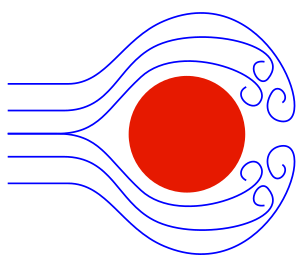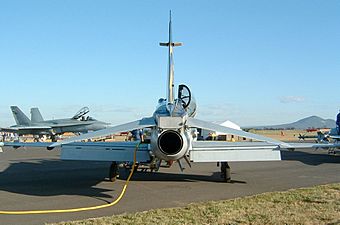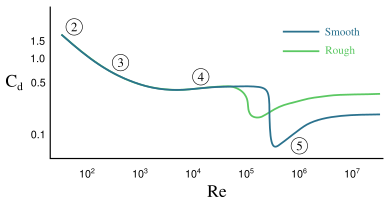Drag (physics) facts for kids
In fluid dynamics, drag (sometimes called resistance) is a force which tends to slow the movement of an object through a liquid or gas. As a moving object pushes the liquid or gas out of its way, the fluid pushes back on the object. This drag force is always opposite to the object's motion, and unlike friction between solid surfaces, the drag force increases as the object moves faster.
Air resistance, also known as drag, is a force that is caused by air, the force acts in the opposite direction to an object moving through the air. It is where air particles hit the front of the object slowing it down. The more surface area, the more air particles hit it and the greater the resistance. For example, a truck with a flat front will experience high air resistance while a sports car with a streamlined shape will experience lower air resistance, allowing the car to go faster. This is why airplanes and other fast machines are streamlined.
Drag can affect the quickest falling speed (the terminal velocity) of an object. The higher the drag, the slower the object falls. A snowflake falls more slowly than does a drop of water of the same weight.
History
The idea that a moving body passing through air or another fluid encounters resistance had been known since the time of Aristotle. According to Mervyn O'Gorman, this was named "drag" by Archibald Reith Low. Louis Charles Breguet's paper of 1922 began efforts to reduce drag by streamlining. Breguet went on to put his ideas into practice by designing several record-breaking aircraft in the 1920s and 1930s. Ludwig Prandtl's boundary layer theory in the 1920s provided the impetus to minimise skin friction. A further major call for streamlining was made by Sir Melvill Jones who provided the theoretical concepts to demonstrate emphatically the importance of streamlining in aircraft design. In 1929 his paper ‘The Streamline Airplane’ presented to the Royal Aeronautical Society was seminal. He proposed an ideal aircraft that would have minimal drag which led to the concepts of a 'clean' monoplane and retractable undercarriage. The aspect of Jones's paper that most shocked the designers of the time was his plot of the horse power required versus velocity, for an actual and an ideal plane. By looking at a data point for a given aircraft and extrapolating it horizontally to the ideal curve, the velocity gain for the same power can be seen. When Jones finished his presentation, a member of the audience described the results as being of the same level of importance as the Carnot cycle in thermodynamics.
Overview
The pressure distribution acting on a body's surface exerts normal forces on the body. Those forces can be summed and the component of that force that acts downstream represents the drag force,  , due to pressure distribution acting on the body. The nature of these normal forces combines shock wave effects, vortex system generation effects, and wake viscous mechanisms.
, due to pressure distribution acting on the body. The nature of these normal forces combines shock wave effects, vortex system generation effects, and wake viscous mechanisms.
The viscosity of the fluid has a major effect on drag. In the absence of viscosity, the pressure forces acting to retard the vehicle are canceled by a pressure force further aft that acts to push the vehicle forward; this is called pressure recovery and the result is that the drag is zero. That is to say, the work the body does on the airflow is reversible and is recovered as there are no frictional effects to convert the flow energy into heat. Pressure recovery acts even in the case of viscous flow. Viscosity, however results in pressure drag and it is the dominant component of drag in the case of vehicles with regions of separated flow, in which the pressure recovery is fairly ineffective.
The friction drag force, which is a tangential force on the aircraft surface, depends substantially on boundary layer configuration and viscosity. The net friction drag,  , is calculated as the downstream projection of the viscous forces evaluated over the body's surface.
, is calculated as the downstream projection of the viscous forces evaluated over the body's surface.
The sum of friction drag and pressure (form) drag is called viscous drag. This drag component is due to viscosity. In a thermodynamic perspective, viscous effects represent irreversible phenomena and, therefore, they create entropy. The calculated viscous drag  use entropy changes to accurately predict the drag force.
use entropy changes to accurately predict the drag force.
When the airplane produces lift, another drag component results. Induced drag, symbolized  , is due to a modification of the pressure distribution due to the trailing vortex system that accompanies the lift production. An alternative perspective on lift and drag is gained from considering the change of momentum of the airflow. The wing intercepts the airflow and forces the flow to move downward. This results in an equal and opposite force acting upward on the wing which is the lift force. The change of momentum of the airflow downward results in a reduction of the rearward momentum of the flow which is the result of a force acting forward on the airflow and applied by the wing to the air flow; an equal but opposite force acts on the wing rearward which is the induced drag. Another drag component, namely wave drag,
, is due to a modification of the pressure distribution due to the trailing vortex system that accompanies the lift production. An alternative perspective on lift and drag is gained from considering the change of momentum of the airflow. The wing intercepts the airflow and forces the flow to move downward. This results in an equal and opposite force acting upward on the wing which is the lift force. The change of momentum of the airflow downward results in a reduction of the rearward momentum of the flow which is the result of a force acting forward on the airflow and applied by the wing to the air flow; an equal but opposite force acts on the wing rearward which is the induced drag. Another drag component, namely wave drag,  , results from shock waves in transonic and supersonic flight speeds. The shock waves induce changes in the boundary layer and pressure distribution over the body surface.
, results from shock waves in transonic and supersonic flight speeds. The shock waves induce changes in the boundary layer and pressure distribution over the body surface.
In summary, there are three ways of categorising drag.
- Pressure drag and friction drag
- Profile drag and induced drag
- Vortex drag, wave drag and wake drag
Types
| Shape and flow | Form Drag |
Skin friction |
|---|---|---|
| ≈0% | ≈100% | |
| ≈10% | ≈90% | |
 |
≈90% | ≈10% |
 |
≈100% | ≈0% |
Types of drag are generally divided into the following categories:
- form drag or pressure drag due to the size and shape of a body
- skin friction drag or viscous drag due to the friction between the fluid and a surface which may be the outside of an object or inside such as the bore of a pipe
- lift-induced drag appears with wings or a lifting body in aviation and with semi-planing or planing hulls for watercraft
- wave drag (aerodynamics) is caused by the presence of shockwaves and first appears at subsonic aircraft speeds when local flow velocities become supersonic. The wave drag of the supersonic Concorde prototype aircraft was reduced at Mach 2 by 1.8% by applying the area rule which extended the rear fuselage 3.73m on the production aircraft.
- wave resistance (ship hydrodynamics) or wave drag occurs when a solid object is moving along a fluid boundary and making surface waves
- boat-tail drag on an aircraft is caused by the angle with which the rear fuselage, or engine nacelle, narrows to the engine exhaust diameter.
The drag equation
Drag depends on the properties of the fluid and on the size, shape, and speed of the object. One way to express this is by means of the drag equation:  where
where
 is the drag force,
is the drag force, is the density of the fluid,
is the density of the fluid, is the speed of the object relative to the fluid,
is the speed of the object relative to the fluid, is the cross sectional area, and
is the cross sectional area, and is the drag coefficient – a dimensionless number.
is the drag coefficient – a dimensionless number.
The drag coefficient depends on the shape of the object and on the Reynolds number  where
where
 is some characteristic diameter or linear dimension. Actually,
is some characteristic diameter or linear dimension. Actually,  is the equivalent diameter
is the equivalent diameter  of the object. For a sphere,
of the object. For a sphere,  is the D of the sphere itself.
is the D of the sphere itself.- For a rectangular shape cross-section in the motion direction,
 , where a and b are the rectangle edges.
, where a and b are the rectangle edges.  is the kinematic viscosity of the fluid (equal to the dynamic viscosity
is the kinematic viscosity of the fluid (equal to the dynamic viscosity  divided by the density
divided by the density  ).
).
At low  ,
,  is asymptotically proportional to
is asymptotically proportional to  , which means that the drag is linearly proportional to the speed, i.e. the drag force on a small sphere moving through a viscous fluid is given by the Stokes Law:
, which means that the drag is linearly proportional to the speed, i.e. the drag force on a small sphere moving through a viscous fluid is given by the Stokes Law:  At high
At high  ,
,  is more or less constant and drag will vary as the square of the speed. The graph to the right shows how
is more or less constant and drag will vary as the square of the speed. The graph to the right shows how  varies with
varies with  for the case of a sphere. Since the power needed to overcome the drag force is the product of the force times speed, the power needed to overcome drag will vary as the square of the speed at low Reynolds numbers and as the cube of the speed at high numbers.
for the case of a sphere. Since the power needed to overcome the drag force is the product of the force times speed, the power needed to overcome drag will vary as the square of the speed at low Reynolds numbers and as the cube of the speed at high numbers.
It can be demonstrated that drag force can be expressed as a function of a dimensionless number, which is dimensionally identical to the Bejan number. Consequently, drag force and drag coefficient can be a function of Bejan number. In fact, from the expression of drag force it has been obtained:  and consequently allows expressing the drag coefficient
and consequently allows expressing the drag coefficient  as a function of Bejan number and the ratio between wet area
as a function of Bejan number and the ratio between wet area  and front area
and front area  :
:  where
where  is the Reynolds number related to fluid path length L.
is the Reynolds number related to fluid path length L.
Images for kids
-
An object falling through viscous medium accelerates quickly towards its terminal speed, approaching gradually as the speed gets nearer to the terminal speed. Whether the object experiences turbulent or laminar drag changes the characteristic shape of the graph with turbulent flow resulting in a constant acceleration for a larger fraction of its accelerating time.
-
Trajectories of three objects thrown at the same angle (70°). The black object does not experience any form of drag and moves along a parabola. The blue object experiences Stokes' drag, and the green object Newton drag.
See also
 In Spanish: Resistencia (fluidos) para niños
In Spanish: Resistencia (fluidos) para niños








